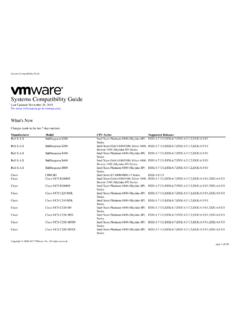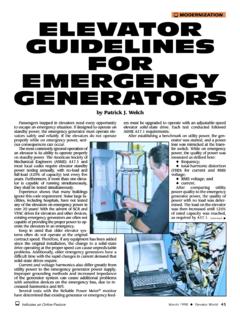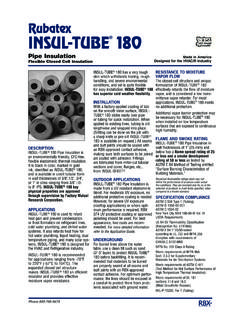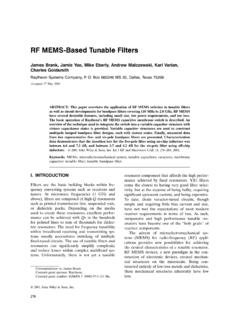Transcription of COMLI - SattControl
1 COMLIS ystem DescriptionCOMLIS ystem DescriptionCopyright 1998 ABB Satt AB. The contents of this document can be changed by ABB Satt AB without prior notice and do notconstitute any binding undertakings from ABB Satt AB. ABB Satt AB is not responsible underany circumstances for direct, indirect, unexpected damage or consequent damage that is causedby this document. All rights :Document version:Document number:Printed in Sweden9903 493-0192-113-2 ForewordSince the first edition of the COMLI system description was published, significant changes have taken place both on ABB Automation s control systems and the COMLI protocol. New systems have been launched and old systems have become obsolete. This has produced new demands on COMLI resulting in new messages emerging and old messages this new version, the chapters related to individual control systems have been omitted to facilitate future updating. Instead, the reader is referred to the COMLI description for the relevant system .
2 Major sec-tions of the description have also been hope that these changes will provide a description that is easier to use and which is updated with all the message types currently in use. ABB Automation reserves the right to make changes to the documenta-tion without prior readers discover any errors, unclear information or have other sugges-tions related to the contents, ABB Automation will be grateful to receive their .. - principle of operation .. interfaces .. message format .. for linking control systems with COMLI ..152 Message types .. of COMLI messages .. of I/O-bits .. data .. modules .. input signals .. text .. ranges and units .. Date and time .. Floating point register .. Trend curve data .. Timers .. Data and program areas .. Time marked events .. Mixed data types .. Terminal mode .. Acknowledge ..923 Supplement .. of checksum BCC .. function .. chart - communication between Master and Slave.
3 Message types .. table ..108 COMLI11 IntroductionCOMLI (COMmunication LInk) is a ABB Automation data transmission sys-tem for communication between control systems and between control systems and computers. COMLI is a conventional communication link using serial, asynchronous data transmission in half duplex mode, one direction at a time, and according to the master/slave document provides detailed information on COMLI for personnel requir-ing a thorough understanding of the system in order to implement COMLI in a particular application or locate faults on a description assumes a knowledge of ABB Automation s control systems and the terminology used in the control system is the most common data communication system used with the ABB Automation family of control systems. Latest generation installations provid-ing operator presentation as well as PLC facilities may use new data transmis-sion systems such as MMS. When COMLI is also used in these new systems, implementation is slightly different to when COMLI is used for data commu-nication between SattCon systems only.
4 Throughout this description it is assumed that only SattCon systems are and SlaveThe terms master and slave are used frequently throughout this handbook. Master in a communications context means the controlling station which always initiates the message transmission sequence. Slave means a reply sta-tion which cannot start a communication sequence but simply responds to calls from the Master notation and ASCII formatWhen communication via COMLI is used 2-digit hexadecimal notation is used to described a byte. This is indicated by the suffix H after the hexadecimal characters. The data in the last byte of the message is coded in hexadecimal format, other bytes are coded in ASCII-hexadecimal Automation s control systems include a memory area called I/O RAM containing the I/O rack s digital input and output signal statuses. In addition to I/O RAM, storage for memory cells, timer indications, limiter modules etc. is also included.
5 An advantage with I/O RAM is that unused channels on the input and output cards can be used as working memory cells for temporary storage of intermediate results. Throughout the remainder of this description the term I/O bit refers to a location in this I/O codesThe following letters are used to identify the various types of address:P = an address of 16 contiguous I/O-bits in = analogue input signal = analogue output signal = 16-bit register COMLI - principle of operationABB Automation s systems communicate with each other and with other com-puters using COMLI (COMmunication LInk). COMLI is one of ABB Auto-mation s communication networks using serial, asynchronous data transmission in half duplex mode (one direction at a time) and in accordance with the Master/Slave principle (the Slave does not reply if there is an error in the message received).Master and Slave can be linked together in different ways to achieve the desired function, Point-to-Point, Multipoint (Multidrop) or radial configu-ration (see the section on Network configuration).
6 Up to 32 Slave systems can be connected to a Master system in a multipoint configuration. Master and Slave are linked via the serial channels on the different systems which are to communicate with each other. Master and Slave need not use the same physi-cal channel numbers in both the systems. They must however have the same character format, transmission speed is controlled by the PLC programs in the different control sys-tems. By activating a predetermined memory cell, the PLC program in the control system acting as Master transmits a message. When the Slave receives the message, it responds either by sending the requested information or by acknowledging the information received. The memory cell is reset when the Master receives the information or an acknowledgement from the information in ABB Automation's control systems is stored in the differ-ent memory modules. About 50 different message types are defined for the various types of information to be the master starts a communication sequence, a communication area determines the type of data to be transferred.
7 The data is transmitted and received via a serial channel defined using a channel definition configurationsThere are two network configurations for a COMLI serial communication net-work: Multipoint communication Point to point communicationCOMLI3 Multipoint communicationSeveral Slave systems are connected to a master in multipoint communication. Communication takes place between Master and one Slave at a time. Direct communication between Slave systems is not possible. A particular message from the Master is applied to all Slaves but only the slave whose unique iden-tity corresponds to the identity contained in the message accepts the data. The number of Slaves which can be connected to each Master is limited by the communication interface. The RS485 interface must be used in multipoint communication. The Master transmit line is connected to all Slave receive lines and all Slave transmit lines are commoned and connected to the Master receive line.
8 RS485 permits 32 Slave systems to be connected to a Master. The COMLI communications software can handle a maximum of 247 of multipoint communicationPoint to point - communicationIn point to point communication, only one Slave system is connected to the Master via one communication interface. Several Slaves can be connected to the Master but this must take place via different communication interfaces. This form of point to point configuration is called a radial (star) network and can provide a higher capacity than multipoint electrical interface can be either RS232/V24 or RS485. A current loop can also be used in certain special cases. This is stated in the relevant system of point-to-point communicationMasterThe Master always initiates the message transmission sequence, whether transmitting data to a slave or requesting data from a slave. The main functions of the Master are: To transmit data to the Slaves and receive the data transmitted by the Slaves.
9 To process the messages received from the Slave. To repeat a message transmission if errors 1 SLAVE 2 SLAVE 3 SLAVE 247 Channel nSLAVE 1 SLAVE 2 MASTERC hannel nChannel m4 COMLIThe processing of messages consists of checking that they are valid, determin-ing the message type and taking the action appropriate to that message type ( entering the status of an I/O bit when a message requesting the status of an I/O bit is transmitted and a valid reply is received).Since the Slave never replies with an error message , the Master always knows how many characters it should receive in a message. If the Master requests a certain quantity of data, the Slave replies with the stated number of bytes or not at to 10 retransmissions can be attempted if any errors are detected (the actual number permitted is system dependent). This is followed by automatic error message printouts in earlier SattCon systems. In other systems, alarm supervi-sion must be connected to a memory cell in the I/O RAM for an error message to be printed transmit/receive sequenceStartTransmission completeTransmit messageStart timeout monitoring Timeout elapsedReply receivedError checkError detectedNo.
10 Transmissions >=10 YESYESYESYESNONONOT ransmissionfailure No. of transmissions > max.**max. = the maximum number of retransmissionsCOMLI5 Master timeoutMaster timeout is the period the master waits to receive a reply before assum-ing an error and retransmitting the message. To avoid timing problems during COMLI communication between systems, the recommendation is that the following timeout periods are used for Masters operating at the various transmission speeds:Transmission speedMaster timeout50 baud25 s110 baud13 s150 baud10 s300 baud7 s600 baud5 s1200 baud4 s2400 baud3 s4800 baud3 s9600 baud3 s19200 baud3 s38400 baud3 sSlaveThe Slave is the passive unit in the communication. A Slave unit waits contin-uously, listening to its receive line. The functions of the Slave are as follows: To receive messages from the Master. To process the message received. To reply to the Master when the processing is processing of the message consists of checking the contents, and taking the necessary action according to the message type ( store the status of an I/O bit when a message containing the status is received and sending a reply indicating the request has been implemented).









